 A History of Alaska Tourism, Part One Seward was one of Alaska's First 'Tourists By DAVE KIFFER July 12, 2010
Although many people had come to Alaska both before and after the 1867 purchase, nearly all had visited either for economic or scientific reasons. Few if any, had come simply to "see the elephant" to use a term popular with the few 19th century people wealthy enough to "travel."
Seward had retired from government service on March 5, 1869. Although he was nearly 70 and in generally poor health, he decided he wanted to spend his remaining years traveling and first on his list was a visit to the land that he had purchased for the United States in 1867. "His friends were surprised and politely hinted that he could not endure the fatigue of a long journey," Frederic Bancroft wrote in his 1967 book: "The Life of William H. Seward." "Although physically a broken down old man, who could not get along without a valet, he seemed to be as unwilling as ever to recognize that anything was impossible for him." In June of 1869, Seward started his journey to Alaska with a railroad trip across the country on then barely one-month-old transcontinental railroad. He saw buffalo and Indian camps and had a lengthy visit with Brigham Young in Salt Lake City. He then visited Sacramento and San Francisco. Prominent Californian businessman Ben Holladay - the so-called Stagecoach King - arranged for Seward and his party to use one of his ships, the Active, for his voyage north. "Some California friends were invited to join the original party and the Active started about the middle of July to visit 'Seward's Arctic Province," Bancroft wrote. The ship visited Seattle and Victoria B.C. and then arrived in Sitka near the end of July. It was there that Seward became involved informally in negotiations with the Chilkat Indians. General Jefferson C. Davis (no relation to the imprisoned former head of the Confederacy, Jefferson F. Davis) had had "trouble" with the Chilkats, who now wanted to make peace, according to Bancroft. Davis and his party, joined Seward and his crew to visit the Chilkats up Lynn Canal. By coincidence, there was a US government survey team also in the area to view a rare total eclipse of the sun. According to Bancroft, the party timed its visit with the Chilkats to coincide with the eclipse. "When the shadow began to pass over the sun the Indians thought that it was caused by the instruments used by the 'Boston Men' as the (visitors) were called," Bancroft wrote. "Some of the Chilkats became greatly alarmed by the darkness and fell on their knees and prayed. When the shadow passed off they were relieved and thought the "Boston Men" were more wonderful than ever." 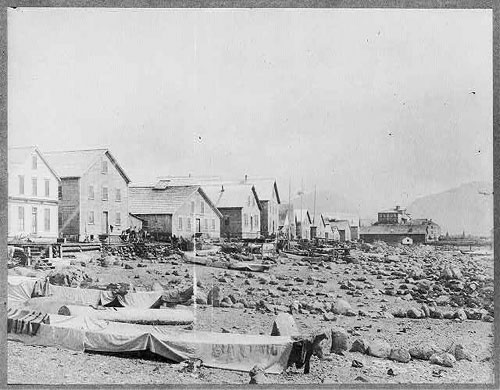 Date Created/Published: c1893. Photographer H.C. Lord. Courtesy Library of Congress Prints and Photographs Division Washington, D.C.
When Seward and his party returned to Sitka in early August, he gave a public address on the wonders of Alaska that he had seen. The written text of the 14-paged, single-spaced speech is in the Alaska State Archives. First, he noted that he had only seen a small part of the state and yet he had covered an area equivalent to making a trip from New England to Memphis. Next, he remarked on the climate which was far from the "ice box" of the detractors of the Alaska purchase. "The weather of this one broad climate of Alaska is severely criticized in outside circles for being too wet and too cold," Seward said. "Nevertheless it must be a fastidious person who complains of climates in which the eagle delights to soar and the hummingbird does not disdain to flutter. It (also) must be confessed at least that it is an honest climate, for it makes no pretensions to constancy." He goes on to say that it is impossible to exaggerate Alaska's physical treasures such as its rivers and its wildlife and notes that its untapped mineral and forest resources will make Alaska a "shipyard for the supply of all nations." Seward also briefly touched on Alaska's potential as a full member of the United States of America. "Nor do I doubt that the political society constituted here, first as a Territory, and ultimately as a State or many States, with prove a worthy constituency of the Republic," he concluded, therefore firing the first salvo in the Alaska statehood battle that would last the next 90 years. After leaving Sitka, Seward sailed south and stopped at Fort Tongass, the American military post near the Canadian border, some 60 miles south of the current location of Ketchikan. 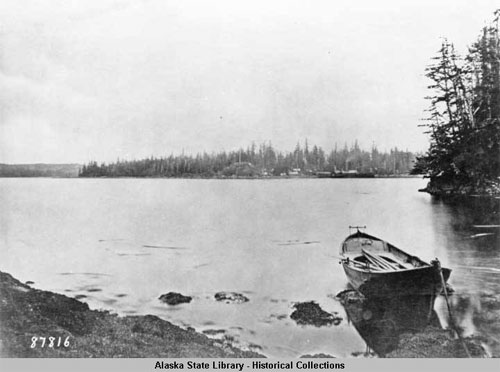 Looking across the water from far shore, with a rowboat in foreground. Verso: An old government military station, 1868 Photograph courtesy Alaska State Library
Bancroft's "Life of William H. Seward" skips the incident entirely, but as recently as March 15, 2009 Daniel Gibson briefly noted the ongoing controversy in Native Peoples Magazine, reporting that Tlingit chief Ebbit originally raised a totem pole in Seward's honor but then later had the visitors ears and nose painted red as a sign of shame when Seward failed to reciprocate the gifts he had been given. After Seward's visit there was a steady trickle of visitors, including naturalist John Muir, who first visited Alaska in 1879, and wrote a bestselling book, Travels in Alaska, in 1879. "To the lover of pure wildness Alaska is one of the most wonderful countries in the world," Muir wrote. "No excursion that I know of may be made into any other American wilderness where so marvelous an abundance of noble, newborn scenery is so charmingly brought to view as on the trip through the Alexander Archipelago to Fort Wrangell and Sitka." 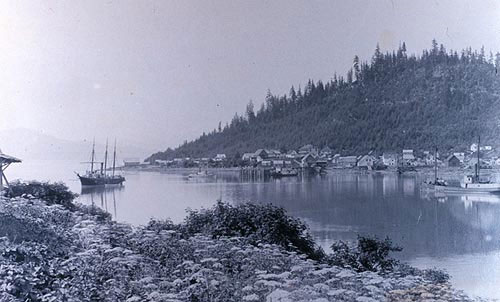 Photo Date: 1890 Ca. Photographer: Archival Photograph by Mr. Steve Nicklas, NGS/RSD Courtesy National Oceanic & Atmospheric Adminstration (NOAA), NOAA Central Library
By the early 1880s, steamships were making regular voyages to Alaska, and along with the miners, fishermen and other settlers, were tourists. Ships going north could be boarded in San Francisco, Tacoma, Port Townsend, Seattle and Victoria. Rail lines advertised trips that included visiting Yellowstone National Park by rail and Alaska via steamship. The natural wonders of Alaska were the selling point: The mountains, the glaciers, the wildlife. But among the natural wonders that visitors saw on their voyages was one spectacular decidedly man-made one. Starting in the early 1880s, the Treadwell mine in Douglas, across Gastineau Channel from Juneau, was the largest gold mine in the world and was visited by the steamships. In her 2010 history of the mine, "Treadwell Gold," Sheila Kelly opens her story with a visit to the mine by dozens of gawking tourists on an early steamship. The visitors were treated to industrial power at its height with 300 stamps operating 24 hours a day - with noise that was first heard by the visitors when they were still eight miles away from the dock - and the 500 foot deep "Glory Hole" growing at the edge of the channel. It was a dramatic counterpoint to the unbridled wilderness that most of the visitors were expecting on the tour. "The tourists went away impressed by the scale of the mine operations," Kelly wrote. "They were amazed at the town's cultural life, charmed by the precocious youngsters and glad to be away from the incessant noise." One of the first organized tours in Alaska was in the summer of 1878 when Captain George S. Wright escorted a group up the Stikine River from Fort Wrangel, according to historian Frank Norris' 1985 book "Gawking at the Midnight Sun." 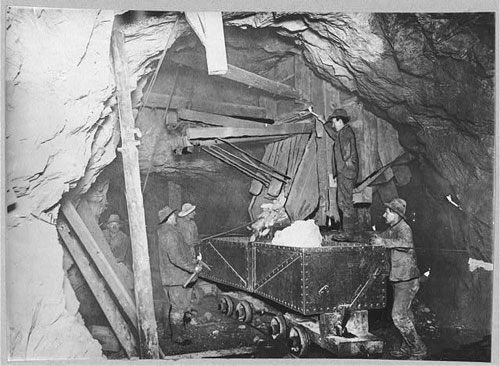 Date Created/Published: 1916. Library of Congress Prints and Photographs Division Washington, D.C.
"In 1881, Victoria's newspaper, The British Colonist" reported that "tourists on board the (steamer) Los Angeles ascended a glacier at Harrisburg (most likely Juneau's Mendenhall Glacier) after which the steamer went on to Chilkat," June Hall wrote in 2007. "They were delighted with the trip. That same summer the first region wide commercial tour took place. Henry Villard escorted General Nelson A. Miles, Commander of the Department of the Columbia, a military band and an excursion part of 80 northward." There was also great excitement in the communities that the steamships visited, according to Hall. She noted the excitement in an 1889 issue of the Sitka newspaper, The Alaskan. "Steamboats! Steamboats! Steamboats! Boys yelling, Indians whooping, businessmen here and there, excited crowds rushing towards the wharf, the whole town in a furore of excitement and waiting with impatience for the lines of the steamboat to be cast ashore, the ship made fast to the wharf. Thus it is on Steamboat Day." With the Pacific Coast Steamship Company dominating most of the industry, there was a generally set pattern to the excursions in the 1880s and 1890s, according to Frank Norris. 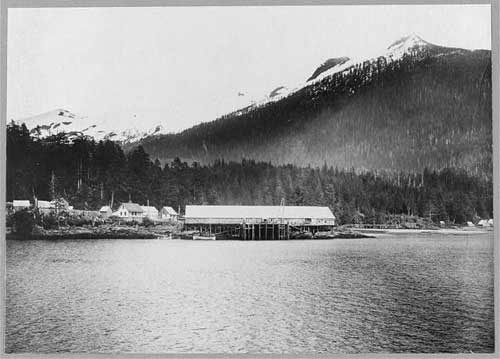 Library of Congress Prints and Photographs Division Washington, D.C.
After the cursory customs stop at Mary Island, the ships steamed north to Fort Wrangel which had been both a Russian and English community since 1834. Norris noted that visitors disembarked in the town to learn its history, see the totem poles and community house and mingle with the Natives. Next up, the ships stopped in Juneau where visitors saw the growing community and then traveled across Gastineau Channel to visit the Treadwell Mine. The ships then steamed northwest to the mouth of Glacier Bay and the spectacular Muir Glacier. When the first explorers passed by Glacier Bay in the late 1700s, they didn't even realize that the bay existed because the Muir and other glaciers extended to the mouth of the bay. By the end of the 1800s, the glaciers had already retreated more than 40 miles into the bay. Heading south from Glacier Bay, most of the ships stopped Killisnoo, near Admiralty Island, where visitors were "amused" by the strong smell of the salmon cannery and herring saltery. 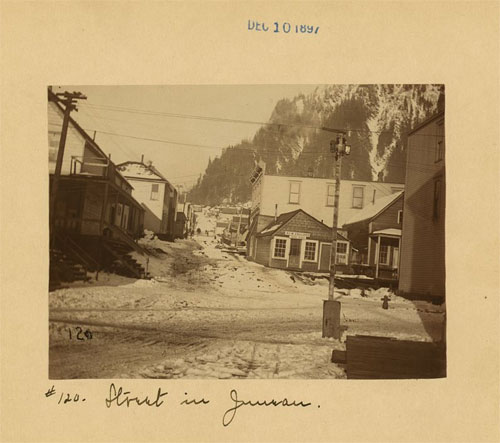 Library of Congress Prints and Photographs Division Washington, D.C.
Occasionally, excursions visited other points in Southeast Alaska, most notably Loring, the Taku Glacier, and the Chilkat villages in upper Lynn Canal where visitors had to opportunity to purchase the valuable, and expensive, Chilkat blankets. From the 1870s on, Alaska also benefited from increased interest by the national media. Two influential books in the early 1870s boosted interest, William Henry Dall's "Alaska and Its Resources" and Frederick Whymper's "Travel and Adventure in the Territory of Alaska". The number of visitors to Alaska on steamships steadily rose from 1,650 in 1884 to 5,007 in 1890, according to historian Robert Campbell in his 2007 book about Alaska tourism "In Darkest Alaska: Travel and Empire Along the Inside Passage." Another major milestone it the "selling" of Alaska came in 1891 when renowned African explorer Edward Glave visited Alaska on behalf of one of the major magazines, "Frank Leslie's Illustrated Newspaper." Glave's articles stretched over three months in nine illustrated parts. Campbell noted in his book that the coverage spurred other magazines and newspapers to make similar visits to Alaska. 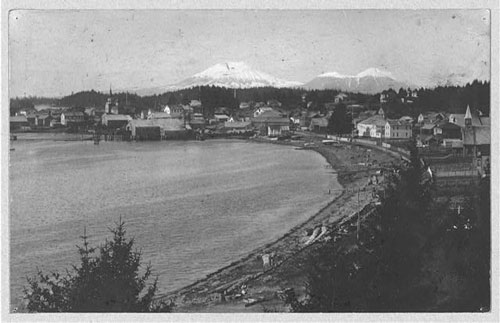 [between ca. 1900 and 1923] Library of Congress Prints and Photographs Division Washington, D.C.
Visits to Alaska increased steadily until 1893, when a national recession took a large bite of tourism in all forms. That recession lasted until 1896, a year in which barely 2,000 visitors came to Alaska. But within a year, more than 100,000 people would begin streaming to Alaska for the Klondike Gold Rush and Alaska and the north country was back in the public eye. For the first couple of years of the rush, 1897 and 1898, the vast majority of the people streaming north were doing it to get rich and "tourism" was swamped as steamship companies and others scrambled to make space available to the "Klondikers." Since the vast majority of the gold rushers didn't get rich - or even mine claims, most of which were gone when they arrived - it has been suggested - by Canadian historian Pierre Berton among others - that most were essentially "tourists." 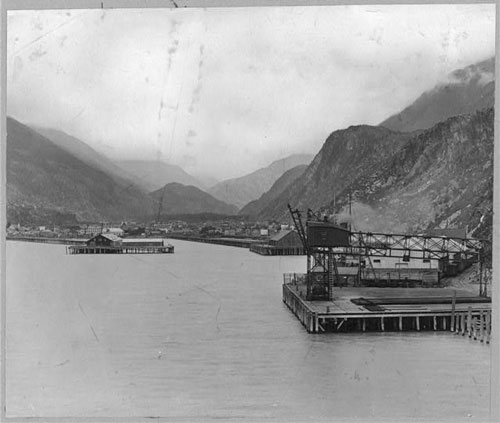 [between ca. 1900 and ca. 1930] Library of Congress Prints and Photographs Division Washington, D.C.
In early 1898, steamship companies anticipated that the all the publicity of the Gold Rush would lead to a boost in actual tourism and began booking excursions again, only now they added Skagway to the ports and in July of 1898, the Skaguay Alaskan reported a visit by a tourist party of 60, according to Norris. "A month later, a tourist ship arrived with 100 curiosity seekers," Norris wrote. "They came to 'participate' in the gold rush and also to ride on the new railroad out of Skagway, construction of which had begun only a few months before. Although just four miles of the line was open, tourists enjoyed the ride to the end of the track." It didn't take long for the residents of Skagway to see a gold rush in the increasing visitor traffic. "By the summer of 1899, tourists were being catered to by local business establishments," Norris wrote. "Skagway's new Chamber of Commerce began allotting money to advertise the town and a first ever clean up day was organized to improve the town's appearance for the tourists." In 1899, train excursions extended to the summit of White Pass and on to Bennett Station in Canada. Among the prominent "visitors" to take the train ride were author/explorer William Henry Dall and Alaska Governor John G. Brady, according to Norris. "By 1900, Skagway had not only become a regular stop on the excursion route, but a railroad trip had become an expected part of the Skagway stop," Norris added. During this period of time, tourism to other parts of Alaska also increased rapidly. River boats began carrying visitors down the Yukon and other rivers from Dawson and Whitehorse and coastal steamers expanded their routes across the Gulf of Alaska to Yakutat, Cordova, Valdez and Seward. Plans were also made in the early 1900s to create access into the Alaskan interior via train and roads. But as tourism began to expand
- the number of visitors topped 7,500 in 1905 - one popular destination
was cut off the excursions. A massive earthquake near Glacier
Bay in 1899 shattered the face of the Muir Glacier, making it
unsafe for steamers to enter the bay. Various attempts were made
to enter the bay up until 1907 before the steamship lines gave
up. After that only specially chartered launches would be allowed
into the Bay until the latter part of the 20th Century.
On the Web:
Dave Kiffer is a freelance writer living in Ketchikan, Alaska. Contact Dave at dave@sitnews.us
|
||
